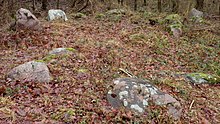Gulstav rotary drum
The round dyssers from Gulstav 1 and 2 (also called Vesterskov 1 + 2) are located in the forest of Vestre Gulstav in the west of Keldsnor , south of Bagenkop in the extreme south of the island of Langeland in Denmark . The Runddysser were around 3300 to 2800 BC. Built during the Neolithic Age and are megalithic systems of the Funnel Beaker Culture (TBK). Nearby is Østre Gulstav Langhøj (Long Hill).
Gulstav 1
The dolmen chamber is located on a partially natural elevation with a few larger curbs. To the east it is chopped off by a forest. The chamber made of four stones forms a square of 2.0 × 2.0 m. To the east of the chamber are two large stones (2.0 × 1.9 m and 1.0 × 1.2 m), which are possibly remnants of the capstone. In the west there are two side stones measuring 0.75 × 0.75 and 1.0 × 1.0 m.
Gulstav 2 (Afd. 611)
The north-west-south-east oriented chamber, located in a round hill about 10.0 m in diameter, consists of four supporting stones and two cap stones. The northern capstone measures about 1.75 × 1.5 × 0.6 m. The southern one measures about 2.0 × 1.75 × 0.6 m. They rest on the northern and western bearing stones, while the bearing stone in the east has overturned.
Østre Gulstav (Afd. 606)
The rectangular, chamberless long hill is oriented northwest-southeast and measures about 15.0 × 4.0 m. The western long side consists of 13 curb stones, the eastern one of 10 curb stones.
See also
literature
- Jens Bech: Monuments on Langeland. (= Tryk from Langelands Museum. Vol. 4, ZDB -ID 2370563-2 ). 2nd edition. Langelands Centraltrykkeri, Rudkøbing 1981.
Individual evidence
- ↑ Runddysse is the common denomination in Denmark for dolmens that are located in a round hill. In contrast, Langdysser are those dolmen that are located in a rectangular or trapezoidal barn bed
Web links

